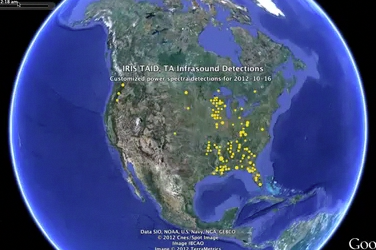Summary
TA Infrasound Detections is an automated IRIS DMC data product produced by systematically scanning USArray Transportable Array broadband infrasound data (40 Hz BDF channel) and generating station-based weekly detection lists. These lists contain raw detections without event association or categorization, which highlight time intervals that may contain potential signals of interest.
Quicklinks
- TA Infrasound Reference Event Database (TAIRED) description
- Automated Event Location Using a Mesh of Arrays (AELUMA):description
- IRIS DMC Infrasound Event Database (IED, contains AELUMA and TAIRED events)
- TA Infrasound Detections (TAID):
Description
TA Infrasound Detections is an automated IRIS DMC data product produced by systematically scanning USArray Transportable Array broadband infrasound data (40 Hz BDF channel) and generating station-based weekly detection lists. These lists contain raw detections without event association or categorization, which highlight time intervals that may contain potential signals of interest.
The detectors utilized by this product operate in the frequency range of 2-5 Hz, without removing the instrument response, and include:
- power spectra detector — calculates power spectra of the signal as a function of time in pre-defined frequency bands. A characteristic function based on the signal’s mean power in the band of interest is used for detection. Some infrasound signals are emergent with long durations. For these signals, their characteristics are often sharper and more easily detected in the frequency domain than in the time domain STA/LTA approach.
- STA/LTA-based detector — a detector similar to classic STA/LTA detectors with an additional fixed time gap between STA and LTA windows to compensate for the emergent nature of the infrasound signals. This gap reduces the level of LTA contamination by the signal.
Two detection lists, full and customized, are compiled for each detector. The longer full lists provide all detections while the shorter, more conservative, customized lists use additional metrics. These lists can serve as an input into user’s own event association algorithm or can be used to get an insight into detection patterns via Google Earth detection visualization or by analyzing the detection rates as described below.
The Google Earth detection visualizations are quick way of scanning detection lists for potential events. In this technique a KML file is generated from one of the detection lists with TimeStamp tags marking the detection times. Detection visualization is then generated by loading this KML file to the Google Earth. The sample video to the right shows such a visualization for the detections of 2012-10-16. The detection list for this day contains signature of an explosion at Camp Minden, Louisiana at 4:25 UTC, along with two other patterns at 00:15 and 20:35 UTC from unknown sources.
Daily customized power spectra detection KML files are available via the KML file links of the TAID Detections Repository. You may also create your own customized KML files using the sample Perl script provided below:
- A Perl script bundle to create KML files from a detection list (README )
- example KML file based on the power spectra detections for 2012-10-16
- full-size QuickTime video of the above visualization
Detection rates provide an insight into the background noise level changes in the station area. Often significant daily increases in the detection rates can be associated with the cultural activities in the area. Image to the right (click on the image for a larger view) shows a graph of full PSD detection rate for the week 36 of 2012 (2012-09-03 to 2012-09-09) for station 959A, Okeechobee, Florida (UTC -4 hours). The chart shows daily increase in detection rate between hours of 13 UTC (9 am local) and 24 UTC (8 pm local), except September 3rd hours that correspond to the local Sunday.
Links below provide access to a sample Perl script that can be used to generate hourly detection rates from a station detection file along with a sample detection rate file.
- A Perl script bundle to calculate detection rates from a detection list (README )
- example detection rate file based on the full power spectra detections for the week 36 of 2012 for station 959A
Table below summarizes parameters used with ‡ denoting those used for customized detections only.
DETECTOR PARAMETERS (common)
| PARAMETER | SAMPLE VALUE |
|---|---|
| parameter | Value |
| Detection cycle | 86400 s (1 day) |
| Processing interval | 14400 s (4 hours) |
| Filter | 2-5 Hz band-pass |
| Maximum detection rate ‡ | 3 per 1200 s (maximum number of detections allowed within the specified time window centered on detection) |
DETECTOR PARAMETERS (Power spectra detector)
| PARAMETER | SAMPLE VALUE |
|---|---|
| Nfft, Number of points for FFT | 1024 (~25 sec @ 40 sps) |
| Overlap | 50% |
| Noise (baseline) window length | 3600 s (mean power spectra) |
| Signal level above baseline for detection | 6 dB |
| Signal level above baseline where detection window extends | 3 dB |
| Minimum detection separation ‡ (closer detections are joined) | 30 s |
| Maximum detection width ‡ (wider detection windows are discarded) | 1800 s |
DETECTOR PARAMETERS (STA/LTA-based detector)
| PARAMETER | SAMPLE VALUE |
|---|---|
| STA window length | 8 s |
| GAP window length | 16 s |
| LTA window length | 72 s |
| STA/LTA threshold | 2.1 |
Citations and DOIs
To cite the IRIS DMC Data Products effort:
- Trabant, C., A. R. Hutko, M. Bahavar, R. Karstens, T. Ahern, and R. Aster (2012), Data Products at the IRIS DMC: Stepping Stones for Research and Other Applications, Seismological Research Letters, 83(5), 846–854, https://doi.org/10.1785/0220120032.
To cite the IRIS DMC Infrasound TA Infrasound Data Products or reference use of its repositories:
- IRIS DMC (2012), Data Services Products: Infrasound TA Infrasound Data Products, https://doi.org/10.17611/DP/IS.1.
Credits
- Manochehr Bahavar, IRIS DMC
Timeline
- 2012-11-20
- Released the TA Infrasound Detections (TAID)








